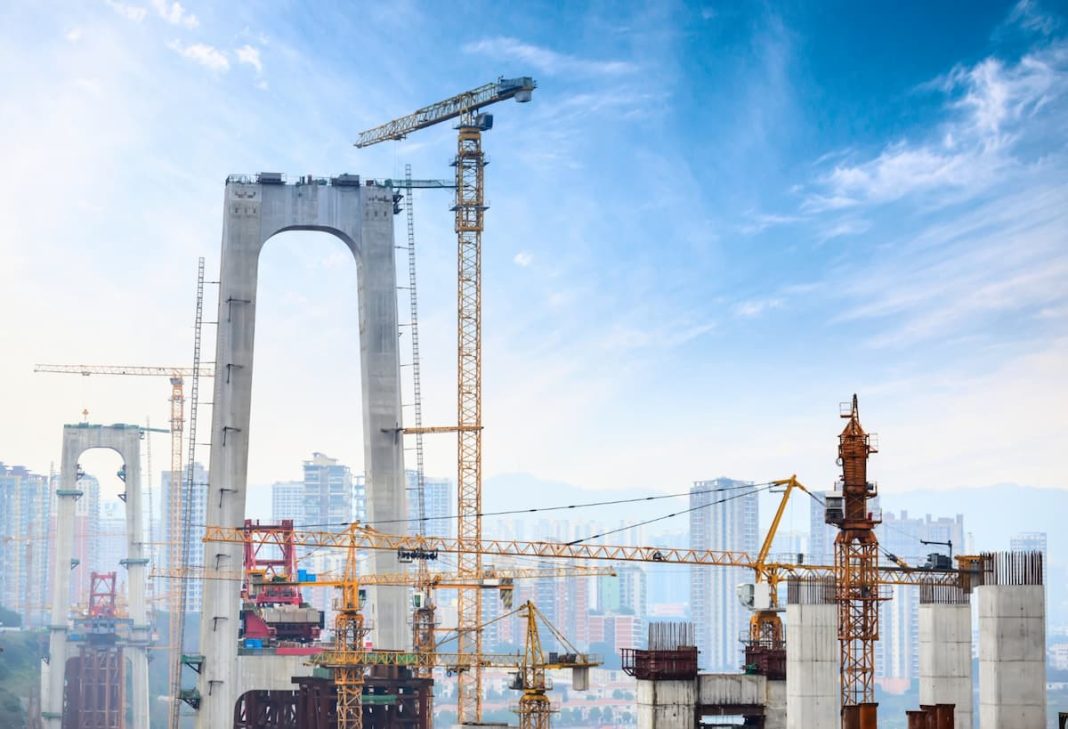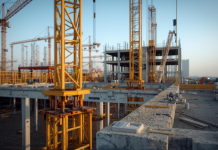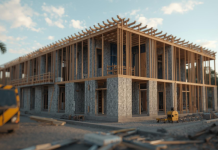In today’s construction news, read about several strategic initiatives unveiled by Sempra (NYSE: SRE) that further the company’s business plan. On the other hand, due to good logistics infrastructure, rising consumer markets, and high tenant demand, the Southeast has become the nation’s leading region for warehouse/distribution (W/D) construction since 2020.
Sempra Announces Deals for Constructing Leading U.S. Utility Growth Business
Original Source: Sempra Announces Strategic Transactions Advancing Goal of Building Leading U.S. Utility Growth Business
SRE (NYSE: SRE) announced several strategic actions to advance its corporate strategy today. Sempra is implementing five value creation initiatives to streamline its business model, boost financial performance, and minimize risk. The company expects these activities to boost earnings growth and customer and community benefits across its service zones.
“The transactions announced today advance Sempra’s capital recycling program and transition to a leading U.S. utility growth business,” said chairman and CEO Jeffrey W. Martin.
Selling Sempra Infrastructure Partners Equity
Sempra stated that it will sell a 45% equity stake in Sempra Infrastructure Partners, one of North America’s largest energy infrastructure platforms, to affiliates of KKR and the Canada Pension Plan Investment Board.
The $10 billion transaction proceeds give Sempra Infrastructure Partners $22.2 billion in equity and $31.7 billion in enterprise value, subject to adjustments.
Before modifications, Sempra expects 47% of the cash at close, 41% by 2027, and the rest seven years later. As Sempra efficiently reinvests funds in capital expenditures at its U.S. utilities, this timetable generates attractive post-closing interest income.
The transaction should close in Q2–Q3 2026, pending regulatory and other approvals and closing conditions.
A KKR-led consortium will own 65% of Sempra Infrastructure Partners after closure, while Sempra will retain 25% and Abu Dhabi Investment Authority (ADIA) will keep 10%. The arrangement grants Sempra and ADIA minority ownership in Sempra Infrastructure Partners.
“The transaction announced today underscores our commitment to extend our strategic partnership with KKR, with whom we have a shared vision of improving America’s position as a global leader in LNG exports,” he said. “It also directly supports our five value creation initiatives designed to simplify our business, efficiently fund strong utility growth in Texas and California, and improve our financial strength.”
“Over the past four years, we have formed a close relationship with the Sempra Infrastructure Partners team and a comprehensive understanding of their company,” said KKR Global Head of Real Assets Raj Agrawal. “We are excited to grow this strategic partnership and are pleased to welcome CPP Investments alongside us as we work to expand Sempra Infrastructure Partners’ assets to help meet growing global demand for energy.”
The transaction also strengthens Sempra’s credit profile, deconsolidates Sempra Infrastructure Partners, improves its business mix with a goal of 95% earnings from regulated U.S. utilities, and eliminates the need for equity issuances in the 2025-2029 capital plan.
The transaction announced today should benefit:
Increases focus on establishing a leading U.S. utility growth business
Reduces business risk by reducing non-utility investments
Balance sheet strength
Improves credit and FFO-to-debt
Adds $0.20 of EPS accretion per year starting in 2027.
Highlights LNG franchise value
Removes 2025–2029 capital plan common equity needs.
Port Arthur Phase 2 Final Investment Choice
Today, Sempra Infrastructure Partners announced a final investment decision to develop, build, and operate Port Arthur LNG Phase 2. The new phase will include two natural gas liquefaction trains, one LNG storage tank, and associated facilities with a nameplate capacity of 13 million tonnes per annum (Mtpa) of U.S.-produced LNG. Estimates place the incremental project capital expenditures for Phase 2 at $12 billion, in addition to $2 billion for shared common facilities. Trains 3 and 4 are expected to begin commercial operations in 2030 and 2031.
Blackstone Credit & Insurance, KKR, Apollo-managed funds, and Private Credit at Goldman Sachs Alternatives are leading the equity investment in Phase 2. These investors bought 49.9% minority stock for $7 billion. Sempra Infrastructure Partners owns 50.1% of the project.
Besides 100% equity finance, Sempra Infrastructure Partners has engaged with worldwide engineering, construction, and project management firm Bechtel Energy Inc., which has received full notice to proceed. Bechtel’s engagement from Phase 1 to Phase 2 should improve economics and reduce execution risk by leveraging efficiencies and learning.
Phase 2 features long-term offtake under 20-year sales and purchase agreements with anchor ConocoPhillips and high-quality counterparties EQT and JERA Co. Sempra Infrastructure Partners and Inc. Sempra Infrastructure Partners expects to enter into further offtake agreements to increase the project’s economic worth, as is industry standard.
Earnings Forecast
Sempra is updating its full-year 2025 GAAP EPS guidance to a range of $3.29 to $3.69 to reflect actual results through the second quarter and certain estimated tax impacts from the equity sale transaction announced today that are expected to be recognized in the third quarter. It is also affirming its adjusted EPS guidance range of $4.30 to $4.70. Sempra is maintaining its full-year 2026 adjusted EPS projection of $4.80 to $5.30, as the Sempra Infrastructure Partners equity sale transaction is expected to finalize in Q2–Q3. The company also expects its long-term EPS The compound annual growth rate is expected to be at the high end or above, ranging from 7% to 9% for the years 2025 through 2029. Subject to Oncor’s base rate review, Sempra will revise its five-year capital plan at its February 2026 fourth-quarter earnings call.
Non-GAAP Financial Measures
Sempra’s adjusted EPS projection ranges and net debt are utilized to calculate inferred enterprise value. Table A provides additional information on non-GAAP financial measurements.
Further Details on Conference Call
At 11 a.m. on Sept. 23, Sempra will hold a conference call to discuss these transactions. EST with company executives. Log onto sempra.com/investors to gain access. The same website has supplemental papers that will be addressed during the call, including a more complete breakdown of the anticipated transaction proceeds, and closing and other adjustments.
Sempra’s website will rebroadcast the webcast a few hours later.
Transaction Advisors
On the Sempra Infrastructure Partners share sale deal, BofA Securities is Sempra’s financial advisor, and Sullivan & Cromwell LLP is its legal advisor.
KKR has Citi as finance advisor and Simpson Thacher as legal advisor. CPP Investments’ legal advisor is Kirkland & Ellis LLP.
About Sempra
Energy infrastructure business Sempra has one of North America’s major energy networks. Sempra electrifies and strengthens some of the world’s largest economic markets and supplies almost 40 million users with energy in California, Texas, and elsewhere. The Dow Jones Sustainability Index North America recognizes Sempra as a leader in responsible business practices and a high-performance culture focused on safety and operational excellence. For more, visit sempra.com or follow @Sempra.
Forward-looking statements are in this press release under the Private Securities Litigation Reform Act of 1995. Forecasts are based on assumptions, risks, and uncertainties and are not guarantees. Future results may differ significantly from forward-looking statements. These forward-looking statements are based on our estimates and assumptions from this news release. We are not required to update or alter forward-looking statements due to new information, future events, or otherwise.
Factors, among others, that could cause actual results and events to differ materially from those expressed or implied in any forward-looking statement include counterparty risk with respect to closing and post-closing payments; the ability to satisfy the conditions to closing, including the receipt of regulatory and other approvals; the ability to achieve the anticipated benefits of the transactions described herein; the effects on such transactions of industry, market, economic, political or regulatory conditions outside of Sempra’s control; the effects on such transactions of disruptions to Sempra Infrastructure’s businesses; transaction costs and purchase price adjustments; transaction-related tax and accounting impacts; the diversion of management time on transaction-related issues; California wildfires, including potential liability for damages regardless of fault and any inability to recover all or a substantial portion of costs from insurance, the wildfire fund established by California Assembly Bill 1054, rates from customers or a combination thereof; decisions, denials of cost recovery, audits, investigations, inquiries, ordered studies, regulations, denials or revocations of permits, consents, approvals or other authorizations, renewals of franchises, and other actions, including the failure to honor contracts and commitments, by the (i) California Public Utilities Commission (CPUC), Comisión Nacional de Energía, U.S. Department of Energy, U.S. Federal Energy Regulatory Commission, U.S. Internal Revenue Service, Public Utility Commission of Texas and other regulatory bodies and (ii) U.S., Mexico and states, counties, cities and other jurisdictions therein and in other countries where we do business; the success of business development efforts, construction projects, acquisitions, divestitures, and other significant transactions, including risks related to (i) being able to make a final investment decision, (ii) negotiating pricing and other terms in definitive contracts, (iii) completing construction projects or other transactions on schedule and budget, (iv) realizing anticipated benefits from any of these efforts if completed, (v) obtaining regulatory and other approvals and (vi) third parties honoring their contracts and commitments; changes to our capital expenditure plans and their potential impact on rate base or other growth; changes, due to evolving economic, political and other factors, to (i) trade and other foreign policy, including the imposition of tariffs by the U.S. and foreign countries, and (ii) laws and regulations, including those related to tax and the energy industry in the U.S. and Mexico; litigation, arbitration, property disputes and other proceedings; cybersecurity threats, including by state and state-sponsored actors, of ransomware or other attacks on our systems or the systems of third parties with which we conduct business, including the energy grid or other energy infrastructure; the availability, uses, sufficiency, and cost of capital resources and our ability to borrow money or otherwise raise capital on favorable terms and meet our obligations, which can be affected by, among other things, (i) actions by credit rating agencies to downgrade our credit ratings or place those ratings on negative outlook, (ii) instability in the capital markets, and (iii) fluctuating interest rates and inflation; the impact on Sempra Infrastructure’s ability to pass through higher costs to customers due to volatility in inflation, interest rates, foreign currency exchange rates and commodity prices and the imposition of tariffs; the impact of climate policies, laws, rules, regulations, trends and required disclosures, including actions to We aim to reduce or eliminate our reliance on natural gas, address the risk of nonrecovery for stranded assets, and manage uncertainties related to emerging technologies. Additionally, we face risks from weather events, natural disasters, pandemics, accidents, equipment failures, explosions, terrorism, information system outages, and other disruptions such as work stoppages that can affect our operations and damage our facilities or systems. These events may lead to the release of harmful materials or fires and could expose us to liability for damages, fines, and penalties—some of which may not be recoverable through regulatory mechanisms or insurance. Furthermore, we must consider the availability of electric power and natural gas storage capacity while being aware of potential disruptions caused by failures in transmission grids or pipelines and limitations on the injection and withdrawal of natural gas from storage facilities. Lastly, there are other uncertainties that are difficult to predict and beyond our control.
Sempra’s U.S. disclosures detail these risks and uncertainties. Securities and Exchange Commission. The SEC’s website, www.sec.gov, and Sempra’s website, www.sempra.com, offer these reports for free through the EDGAR system. Investors should not overthink forward-looking statements.
Sempra 2025 and 2026 adjusted EPS guidance ranges are non-GAAP. These non-GAAP financial measures exclude substantial factors that are not relevant to our business activities or relatively uncommon. These non-GAAP financial measures also leave out the effects of foreign currency and inflation on our money in Mexico, as well as unrealized gains and losses on commodity and interest rate derivatives, which we think will happen in the future and can change a lot. Excluding these things helps management and investors compare Sempra’s business operations to past and future periods. Non-GAAP financial measurements should be studied alongside GAAP data, not in place of it.
This is not a substitute for Sempra 2025 GAAP EPS Guidance Range. The table below compares the Sempra 2025 Adjusted EPS Guidance Range to the GAAP-calculated EPS Guidance Range, the most directly comparable financial measure.
Speculative Southeast Industrial Construction
Original Source: Southeast Industrial Speculative Construction
Strong tenant demand, attractive logistics infrastructure, and access to developing consumer markets have made the Southeast a national leader in warehouse/distribution (W/D) construction since 2020. Speculative construction increased, with approximately 429.7 million square feet delivered in the region. Recent quarters have seen activity stagnate because to rising interest rates, vacancies, and economic uncertainty.
Mid-size buildings (100,000–299,999 sf) were the most active and resilient segment in 2025, with most deliveries and construction starts. Despite a decline in big-box development, certain first-generation spec sites still attract significant tenants. The market severely undersupplies small-bay facilities, which account for much of the leasing demand.
Major markets like Atlanta and Savannah and rising markets like South Florida and Jacksonville are developing 39.5 msf of speculative W/D space as of mid-2025. Developers are projected to favor build-to-suit developments with smaller footprints to meet tenant preferences and market conditions.
This paper examines speculative construction in Southeast industrial markets.
Summary of today’s construction news
In summary, the transaction offers several benefits: deconsolidating Sempra Infrastructure Partners, enhancing Sempra’s business mix to achieve approximately 95% of earnings from regulated U.S. utilities, and removing the necessity for equity issuances in the previously announced 2025-2029 capital plan. It also helps strengthen Sempra’s credit profile. A $10 billion cash sale of 45 percent of Sempra Infrastructure Partners has been agreed upon.
On the other hand, key locations like Atlanta and Savannah, as well as rising markets like South Florida and Jacksonville, are seeing a concentration of development, with 39.5 msf of speculative W/D space still under construction as of mid-2025. In the future, developers are predicted to move toward smaller footprints and build-to-suit developments in order to better adapt to changing tenant tastes and market circumstances.








